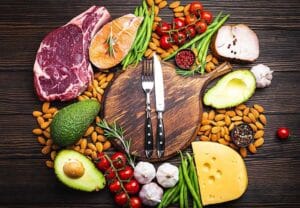How a Low-Carb Diet Alters Your Gut Microbiome
Right now in the U.S., millions of microbiomes are searching hard for one essential ingredient: carbs.
Carbohydrates, the sugar molecules found in starches, fiber, and sugars, have been reduced or cut out of an estimated 6% of American diets. And that figure is likely bumping up a bit right now, as more people consider low-carb diets as a fast solution to gaining slimmer summer silhouettes.

So in the place of bread, fruits, beans, and starchy vegetables, low-carb adherents load up on natural fats, proteins, and “above-ground” vegetables, such as broccoli, cauliflower, and cucumbers. But in doing so, they are eliminating one of the three main nutrients our bodies need (carbs) – the others being fat and protein.
The result, in addition to weight loss, can be nausea, headaches, muscle soreness, and constipation. These effects are sometimes referred to as the Keto or carb flu.
Why does this discomfort occur? It comes down to a disruption in the gut microbiome, the trillions of bacteria, viruses, and fungi that break down nutrients as they travel through the intestines. Let’s explore our guts to learn more.
The Role of Carbs in Digestion
The main job of carbohydrates is to provide the body energy. Our microbiomes break sugar and starch carbs down into glucose, which is carried to the cells to fuel metabolism. Excess carbs in the digestion system become stored energy.
Dietary fibers such as oats, whole grains, and legumes, however, are not broken down into glucose. These carbs pass through the body undigested and support digestive health, or “regularity.” They also promote the growth of the gut’s “good” bacteria, which produce short-chain fatty acids that fight off disease-causing bacteria.
Generally, cells prefer carbs as their primary energy source, so when these nutrients are eliminated, the microbiome seeks adjustments.
How the Gut Responds When It Can’t Find Carbs
Your body can be highly adaptive to change, but not without side effects. For example, if it’s low on carbs to convert into glucose, the body might break down muscle into amino acids that can be turned into glucose to generate energy. This can cause muscle soreness.
Further, the liver will transform stored fats into a fuel called ketones, triggering the process called ketosis. Evidence of this process include bad breath (from the release of the ketones), fatigue, and headaches.
And perhaps most important: When the body doesn’t have enough sugar to run as it should, the microbiome will produce fewer short-chain fatty acids and antioxidants. These compounds are important for reducing inflammation and the risk of colon cancer.
Consult a Doctor Before Cutting Carbs
Scientific research has shown that the composition and activity of the gut microbiome “are profoundly dependent on the dietary intake of carbohydrates and proteins.” Therefore, a gut-healthy diet should include a high amount of complex carbohydrates, including fruits and vegetables – some recommend 900 to 1,300 calories worth a day (based on your height, weight, and activity).
That being said, we recognize that for some people a low-carb diet can help ease health conditions including diabetes and seizures. And specific-carbohydrate diets, which cut grains and starchy fruits and vegetables that are hard to digest, could reduce symptoms of colitis.
If you live with these conditions and have not made dietary changes, it may be time to call a doctor.
If you are otherwise healthy but curious about trying a low- or no-carb diet, you also should consult a doctor to gauge a baseline of your dietary health.
Then, your doctor or a dietician can help determine the best diet to satisfy your hungry microbiome.
To learn more about the gut microbiome and its role in digestion, read our blog on the topic here. If you’d like to consult with someone on the Cincinnati GI team about a diet plan, you can send a general inquiry to us easily, through our online portal.
